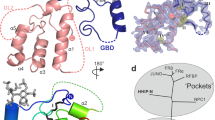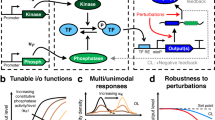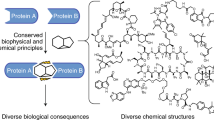Abstract
Small-molecule inhibition of extracellular proteins that activate membrane receptors has proven to be extremely challenging. Diversity-oriented synthesis and small-molecule microarrays enabled the discovery of robotnikinin, a small molecule that binds the extracellular Sonic hedgehog (Shh) protein and blocks Shh signaling in cell lines, human primary keratinocytes and a synthetic model of human skin. Shh pathway activity is rescued by small-molecule agonists of Smoothened, which functions immediately downstream of the Shh receptor Patched.
This is a preview of subscription content, access via your institution
Access options
Subscribe to this journal
Receive 12 print issues and online access
$259.00 per year
only $21.58 per issue
Buy this article
- Purchase on Springer Link
- Instant access to full article PDF
Prices may be subject to local taxes which are calculated during checkout


Similar content being viewed by others
References
Ingham, P.W. & McMahon, A.P. Genes Dev. 15, 3059–3087 (2001).
Rubin, L. & de Sauvage, F.J. Nat. Rev. Drug Discov. 5, 1026–1033 (2006).
Nusslein-Volhard, C. & Wieschaus, E. Nature 287, 795–801 (1980).
Chen, J.K., Taipale, J., Young, K.E., Maiti, T. & Beachy, P.A. Proc. Natl. Acad. Sci. USA 99, 14071–14076 (2002).
Chen, J.K., Taipale, J., Cooper, M.K. & Beachy, P.A. Genes Dev. 16, 2743–2748 (2002).
Williams, J.A. et al. Proc. Natl. Acad. Sci. USA 100, 4616–4621 (2003).
Ding, S. & Schultz, P.G. Nat. Biotechnol. 22, 833–840 (2004).
Wu, X. et al. Chem. Biol. 11, 1229–1238 (2004).
Wang, B., Fallon, J.F. & Beachy, P.A. Cell 100, 423–434 (2000).
Chiang, C. et al. Nature 383, 407–413 (1996).
Thayer, S.P. et al. Nature 425, 851–856 (2003).
Von Hoff, D.D. et al. in Proceedings of the 99th Annual Meeting of the American Association of Cancer Research, San Diego, April 12–16, 2008, abstract LB-138 (American Association of Cancer Research, Philadelphia, 2008).
Epstein, E.H. Nat. Rev. Cancer 8, 743–754 (2008).
MacBeath, G., Koehler, A.N. & Schreiber, S.L. J. Am. Chem. Soc. 121, 7967–7968 (1999).
Kuruvilla, F.G. et al. Nature 416, 653–657 (2002).
Tan, D.S. Nat. Biotechnol. 20, 561–563 (2002).
Burke, M.D., Berger, E.M. & Schreiber, S.L. Science 302, 613–618 (2003).
Wong, J.C. et al. Chem. Biol. 11, 1279–1291 (2004).
Bradner, J.E. et al. Chem. Biol. 13, 493–504 (2006).
Taipale, J. et al. Nature 406, 1005–1009 (2000).
Sinha, S. & Chen, J.K. Nat. Chem. Biol. 2, 29–30 (2006).
Chen, J.K., Taipale, J., Cooper, M.K. & Beachy, P.A. Genes Dev. 16, 2743–2748 (2002).
Spinella-Jaegle, S. et al. J. Cell Sci. 114, 2085–2094 (2001).
Yao, S., Lum, L. & Beachy, P.A. Cell 125, 343–357 (2006).
Tenzen, T. et al. Dev. Cell 10, 647–656 (2006).
Acknowledgements
We thank M.A. Foley for suggesting the use of robotnikinin in primary cell and tissue models in the Mandinova laboratory, A.M. Stern for his insightful guidance and critique and G. Copeland, O. McPherson, D. Young and T. Lewis for their helpful suggestions. This work was funded by the US National Institute of General Medical Sciences (GM-38627 awarded to S.L.S.), the National Pancreas Foundation, American Gastroenterological Association and American Liver Foundation (L.F.P.), and in part with funds from the US National Cancer Institute's Initiative for Chemical Genetics (contract no. N01-CO-12400). The content of this publication does not necessarily reflect the views or policies of the US Department of Health and Human Services, nor does the mention of trade names, commercial products or organizations imply endorsement by the US government. S.L.S. is a Howard Hughes Medical Institute Investigator.
Author information
Authors and Affiliations
Corresponding authors
Ethics declarations
Competing interests
S.L.S. is a shareholder of Infinity Pharmaceuticals, a company to which reference is made in the text. All other authors declare that they have no competing financial interests.
Supplementary information
Supplementary Text and Figures
Supplementary Figures 1 and 2 and Supplementary Methods (PDF 557 kb)
Rights and permissions
About this article
Cite this article
Stanton, B., Peng, L., Maloof, N. et al. A small molecule that binds Hedgehog and blocks its signaling in human cells. Nat Chem Biol 5, 154–156 (2009). https://doi.org/10.1038/nchembio.142
Received:
Accepted:
Published:
Issue Date:
DOI: https://doi.org/10.1038/nchembio.142
This article is cited by
-
Hedgehog signaling in tissue homeostasis, cancers, and targeted therapies
Signal Transduction and Targeted Therapy (2023)
-
Molecular mechanisms underlying the action of carcinogens in gastric cancer with a glimpse into targeted therapy
Cellular Oncology (2022)
-
Aberrant activation of the Hedgehog signalling pathway in squamous cell carcinoma of the vulva as a potential target for cancer therapy
Scientific Reports (2021)
-
Safety and Tolerability of Sonic Hedgehog Pathway Inhibitors in Cancer
Drug Safety (2019)
-
Targeting human respiratory syncytial virus transcription anti-termination factor M2-1 to inhibit in vivo viral replication
Scientific Reports (2016)



